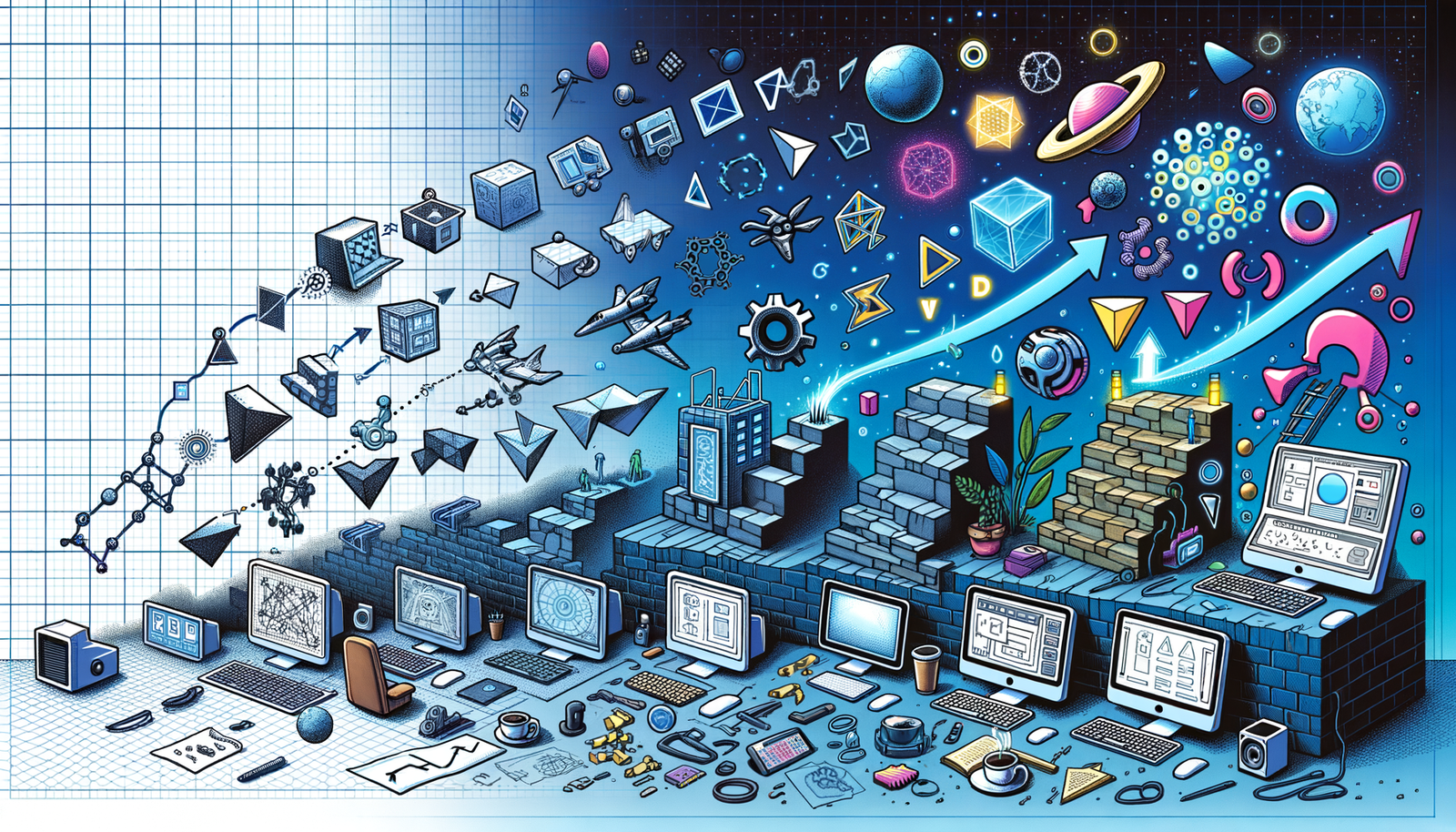Your Cart is Empty
Customer Testimonials
-
"Great customer service. The folks at Novedge were super helpful in navigating a somewhat complicated order including software upgrades and serial numbers in various stages of inactivity. They were friendly and helpful throughout the process.."
Ruben Ruckmark
"Quick & very helpful. We have been using Novedge for years and are very happy with their quick service when we need to make a purchase and excellent support resolving any issues."
Will Woodson
"Scott is the best. He reminds me about subscriptions dates, guides me in the correct direction for updates. He always responds promptly to me. He is literally the reason I continue to work with Novedge and will do so in the future."
Edward Mchugh
"Calvin Lok is “the man”. After my purchase of Sketchup 2021, he called me and provided step-by-step instructions to ease me through difficulties I was having with the setup of my new software."
Mike Borzage
Design Software History: The Evolution of Data Visualization in CAD Software: From 2D Drafting to Advanced 3D Modeling and Emerging Technologies
April 09, 2025 12 min read


Contextual Overview
In today's rapidly evolving technological landscape, data visualization has become an integral component of **Computer-Aided Design (CAD) software**. Data visualization in CAD involves the graphical representation of complex design data to enhance understanding, analysis, and communication among designers, engineers, and stakeholders. As designs become more intricate and datasets more substantial, the capacity to visually interpret this information effectively is paramount. Data visualization transforms numerical and textual data into visual contexts, such as graphs, charts, and models, making it easier to recognize patterns, trends, and outliers in the design process. The significance of data visualization in CAD software cannot be overstated. It bridges the gap between abstract data and tangible insight, enabling professionals across engineering and design disciplines to make informed decisions swiftly. Visualization tools in CAD allow for the simulation of real-world physics, material properties, and environmental conditions, facilitating a deeper understanding of how a design will perform under various scenarios. This is crucial in fields such as aerospace, automotive, and architecture, where design decisions have profound implications for safety, efficiency, and aesthetics. Moreover, the rising importance of visualization for decision-making is evident in the collaborative nature of modern design projects. Teams often comprise members from diverse backgrounds who may not be familiar with technical jargon or complex data structures. Visualizations provide a common language that enhances communication and reduces misunderstandings. They enable stakeholders to grasp complex concepts quickly, thereby accelerating the iterative process of design and refinement. In an era where time-to-market is critical, the ability to make **data-driven decisions** efficiently is a significant competitive advantage. Data visualization also aids in identifying design flaws early in the development cycle, saving time and resources. By visualizing stress distributions, thermal analyses, and fluid dynamics, engineers can detect potential issues before physical prototypes are built. This predictive capability is essential for optimizing designs and ensuring compliance with industry standards and regulations. In summary, data visualization in CAD software is a crucial tool that enhances the decision-making process, fosters collaboration, and drives innovation across engineering and design disciplines.Historical Context
The journey of data visualization in CAD software began with the integration of simple visualization features in early CAD systems. In the 1960s and 1970s, CAD software primarily provided basic 2D drafting capabilities, which were revolutionary at the time for replacing manual drafting methods. Early systems like Sketchpad, developed by Ivan Sutherland at MIT in 1963, laid the groundwork for interactive computer graphics and introduced the concept of manipulating objects directly on a screen. The initial visualization features were limited due to hardware and software constraints, offering simplistic line drawings and wireframe models. As computing technology advanced, the 1980s saw the introduction of more sophisticated CAD systems. Companies like **Autodesk**, founded by John Walker in 1982, emerged as key players by releasing AutoCAD, which became one of the most widely used CAD programs. AutoCAD introduced enhanced visualization tools, allowing for better representation of designs with added layers and color coding. Identifying key milestones in the evolution of data visualization includes the introduction of 3D modeling capabilities. The late 1980s and early 1990s witnessed significant innovations with companies like **Dassault Systèmes** introducing CATIA, a CAD system that enabled complex surface modeling and became a standard in the aerospace and automotive industries. The ability to visualize designs in three dimensions was a monumental shift, allowing engineers and designers to perceive spatial relationships and design intricacies more effectively. Another significant milestone was the development of shading and rendering techniques. The incorporation of **Gouraud shading** and **Phong shading** algorithms enhanced the visual realism of models, providing a more accurate representation of how objects would appear in the real world. The evolution continued with the advent of parametric modeling and feature-based design in software like PTC's Pro/ENGINEER, which allowed for more dynamic and interactive visualizations that could be easily modified through parameters. The progression of data visualization in CAD software has been closely tied to advancements in computing power and graphics processing capabilities. The historical context underscores a trajectory from simple 2D representations to complex, interactive 3D models with realistic rendering. Each innovation has expanded the possibilities of what designers and engineers can conceptualize and communicate, highlighting the critical role of visualization in the evolution of CAD software.Pioneering Technologies and Software
The evolution of data visualization in CAD software has been significantly shaped by pioneering technologies and software that laid the foundation for modern design tools. Early CAD programs were instrumental in incorporating basic data visualization capabilities, transforming the way designers and engineers approached the creation and modification of technical drawings. One of the earliest examples is the aforementioned Sketchpad, which introduced the concept of interactive graphics and object-oriented drawing, allowing users to manipulate visual representations directly. As CAD software evolved, companies like **Autodesk** and **Dassault Systèmes** emerged as leaders in the industry. Autodesk's AutoCAD provided accessible CAD tools for a wider range of users, supporting both 2D drafting and, eventually, 3D modeling. Its introduction of the **Model Space/Paper Space** concept allowed for more effective visualization of designs in both working and presentation contexts. AutoCAD's support for external references and layers enhanced the ability to manage complex drawings with multiple components. Dassault Systèmes' CATIA, initially developed to meet the demanding needs of aircraft manufacturer Dassault Aviation, offered advanced surface modeling and assembly capabilities. CATIA's visualization tools enabled designers to create highly detailed and accurate 3D models, which were essential for industries requiring precision and compliance with strict standards. The software's ability to handle large assemblies and complex surfaces made it a preferred choice for automotive and aerospace design, emphasizing the importance of robust visualization in managing intricate projects. Another notable contribution came from **PTC's Pro/ENGINEER**, which introduced parametric, feature-based modeling. This approach allowed for dynamic adjustments to models based on defined parameters, enhancing the visualization process by enabling real-time updates and modifications. Pro/ENGINEER's visualization features, such as shaded rendering and dynamic viewing, improved the user's ability to comprehend the model's geometry and design intent. To summarize some of the pioneering CAD software incorporating basic visualization capabilities:- Sketchpad: Introduced interactive computer graphics and object manipulation.
- AutoCAD by Autodesk: Provided accessible 2D drafting and later 3D modeling with visualization tools like layers and color coding.
- CATIA by Dassault Systèmes: Enabled advanced surface modeling and assembly visualization for complex industries.
- Pro/ENGINEER by PTC: Introduced parametric, feature-based modeling with dynamic visualization features.
Academic Contributions
Academic institutions have played a pivotal role in advancing visualization technologies and methodologies within CAD software. Universities and research institutions have been at the forefront of developing the underlying mathematical models and algorithms that enable advanced data visualization. The collaboration between academia and industry has led to significant breakthroughs that have directly influenced commercial software development. One key area of academic contribution is the development of computational geometry and computer graphics algorithms. Pioneering work in these fields provided the foundation for representing complex shapes and surfaces in digital form. For example, **Bézier curves**, developed by French engineer Pierre Bézier while working at Renault, and **B-spline curves** and surfaces, formulated through academic research, have become essential tools in modeling free-form shapes in CAD software. These mathematical representations allow for the precise control and manipulation of curves and surfaces, which are critical in automotive and aerospace design. Academic research has also led to advancements in rendering techniques. The development of shading algorithms, such as **Phong shading** introduced by Bui Tuong Phong at the University of Utah, enhanced the realism of visualizations by simulating the way light interacts with surfaces. This contribution significantly improved the visual quality of 3D models in CAD software, allowing designers to better predict how their designs would appear in real-life conditions. Additionally, universities have contributed to the development of virtual reality (VR) and augmented reality (AR) technologies for CAD applications. Research into immersive environments provides new ways to visualize and interact with design data. Institutions like MIT and Stanford have conducted studies on human-computer interaction and visualization techniques that improve user experience and comprehension in CAD systems. These studies inform software developers on how to implement more intuitive and effective visualization tools. Academic conferences and publications serve as platforms for disseminating research findings that influence commercial software. The exchange of knowledge through journals like **Computer-Aided Design** and conferences such as the **SIGGRAPH** (Special Interest Group on Computer Graphics and Interactive Techniques) has fostered innovation and collaboration between researchers and industry professionals. This synergy ensures that the latest theoretical advancements are translated into practical applications within CAD software, continually pushing the boundaries of what's possible in data visualization.Technological Progression
The progression from basic 2D visual representations to sophisticated 3D models marks a significant evolution in CAD software's data visualization capabilities. In the early days, CAD systems were primarily used for creating digital versions of traditional hand-drawn blueprints. These 2D representations, while an improvement over manual drafting, were limited in their ability to convey depth and spatial relationships. As a result, engineers often had to rely on multiple views and cross-sections to understand the full scope of a design. The transition to 3D visualization began in earnest with the advent of more powerful computing systems and advances in software engineering. The development of solid modeling techniques, such as **Constructive Solid Geometry (CSG)** and **Boundary Representation (B-rep)**, allowed for the creation of complete 3D models that represented both the surfaces and the volumes of objects. This was a significant leap forward, enabling designers to visualize and manipulate complex geometries in a way that was not possible with 2D drawings. Improvements in computing power and graphics hardware had a profound impact on visualization capabilities. The introduction of specialized graphics processing units (GPUs) allowed for real-time rendering of complex models. This enabled features like dynamic rotation, zooming, and panning of 3D models, making the design process more interactive and intuitive. High-resolution displays and improved screen refresh rates also enhanced the clarity and responsiveness of visualizations. Furthermore, the adoption of **OpenGL** and **DirectX** graphics APIs standardized the way 3D graphics were rendered, allowing software developers to create more advanced visualization features. These technologies facilitated the implementation of shading, texturing, and lighting effects that added realism to models. As a result, designers could simulate real-world conditions and materials, improving the accuracy of visual assessments. The advancement from 2D to 3D visualization transformed the design process by providing a more comprehensive understanding of how different components interact within a system. It reduced the likelihood of errors and misinterpretations that were common with 2D drawings. Moreover, 3D visualization opened up new possibilities for simulation and analysis, such as finite element analysis (FEA) and computational fluid dynamics (CFD), which rely heavily on accurate 3D models to predict performance under various conditions.Integration of Advanced Features
The integration of advanced features into CAD software has significantly enhanced data visualization, making it more powerful and versatile than ever before. One of the most impactful advancements has been the introduction of **real-time rendering**, which allows designers to view changes to models instantaneously. Real-time rendering provides immediate visual feedback, enabling faster iterations and more efficient design workflows. Another significant development is **volumetric visualization**, which extends beyond surface representations to include the internal characteristics of a model. This is particularly useful in fields such as medical device design and materials engineering, where understanding the internal structure is crucial. Volumetric visualization enables the representation of data that varies over a volume, such as density or stress distribution, providing deeper insights into how a design will perform. The incorporation of **augmented reality (AR)** and **virtual reality (VR)** into CAD visualization tools has further expanded the capabilities of designers and engineers. AR allows users to overlay digital models onto the physical world, facilitating tasks like on-site design reviews and spatial planning. VR provides immersive environments where users can interact with designs at full scale, improving spatial understanding and aiding in the detection of potential issues that might not be evident on a screen. The role of mathematical models and algorithms in enhancing visualization precision and utility is fundamental. Advanced algorithms for rendering, such as **ray tracing** and **global illumination**, produce highly realistic images by simulating the physical behavior of light. These techniques require significant computational resources but result in visualizations that closely mimic real-world appearances. Additionally, algorithms for data reduction and visualization, such as **marching cubes** for isosurface extraction and **principal component analysis (PCA)** for dimensionality reduction, enable the handling of large datasets efficiently. These mathematical tools allow for the visualization of complex phenomena without overwhelming the user with excessive detail. Furthermore, the integration of **parametric modeling** and **generative design** leverages algorithms to automatically generate optimized designs based on specified constraints and objectives. Visualization plays a crucial role in this process, as it allows designers to evaluate and compare multiple generated solutions effectively. Incorporating these advanced features into CAD software has made data visualization a more powerful tool for innovation. By providing more accurate, realistic, and interactive visualizations, designers and engineers can explore more design possibilities, identify potential issues early, and communicate ideas more effectively with stakeholders.Current Trends and Emerging Technologies
The future of data visualization in CAD software is being shaped by several cutting-edge trends and emerging technologies that promise to further revolutionize the field. One of the most significant trends is the integration of **Artificial Intelligence (AI)** and **Machine Learning (ML)** into visualization processes. AI-driven visualization utilizes algorithms to automate and enhance various aspects of the design process. For instance, AI can analyze large datasets to identify patterns and suggest design optimizations, which are then visually represented within the CAD environment. **Big data integration** is another trend influencing the evolution of CAD visualization. With the increasing ability to collect and process vast amounts of data from simulations, sensors, and user inputs, CAD software is becoming more data-centric. The challenge lies in effectively visualizing this data so that it can inform decision-making without overwhelming the user. Advanced visualization techniques, such as interactive dashboards and data analytics tools within CAD software, are being developed to address this challenge. The emergence of **cloud computing** and **collaborative platforms** is also impacting CAD visualization. Cloud-based CAD solutions enable real-time collaboration among geographically dispersed teams, with visualization tools that support simultaneous viewing and editing of models. This enhances productivity and accelerates the design process by allowing instant feedback and adjustments. Emerging technologies influencing the future of CAD visualization include:- Artificial Intelligence (AI) and Machine Learning (ML): Automating and enhancing visualization processes.
- Big Data Integration: Managing and visualizing vast amounts of design data.
- Cloud Computing and Collaborative Platforms: Enabling real-time collaboration and visualization among dispersed teams.
- Haptic Feedback and Tactile Interfaces: Providing immersive experiences by incorporating touch into visualization.
Summary of Impact
The evolution of data visualization in CAD software has fundamentally transformed design processes and outcomes across various industries. From the early days of simple 2D representations to today's complex 3D models with real-time rendering and simulation capabilities, visualization has been at the heart of innovation in design and engineering. It has enabled professionals to conceptualize, analyze, and communicate ideas more effectively, leading to better products and structures that meet the needs of society. Data visualization has improved design efficiency by reducing the time required to develop and refine concepts. With advanced visualization tools, designers can quickly identify and address issues, optimize designs, and explore alternative solutions. This iterative process is enhanced by visualization's ability to make complex data understandable and actionable. As a result, products reach the market faster, and projects are completed more promptly, providing a competitive advantage in fast-paced industries. Collaboration has also been significantly enhanced through visualization. By providing a common visual language, data visualization bridges gaps between team members with different expertise and stakeholders who may not have technical backgrounds. This fosters better communication, reduces misunderstandings, and aligns teams toward common goals. Visualization tools that support collaborative workflows enable multiple users to engage with designs simultaneously, sharing insights and feedback in real-time. The ongoing importance of visualization in improving innovation cannot be overstated. As designs become more complex and data continues to grow in volume and complexity, visualization will remain a critical tool for making sense of information and driving creative solutions. The integration of emerging technologies will further enhance the power of visualization, enabling designers to tackle new challenges and push the boundaries of what's possible. In conclusion, data visualization in CAD software has been, and will continue to be, a cornerstone of modern design and engineering practices. Its impact on efficiency, collaboration, and innovation underscores its significance in shaping the future of various industries. As technology advances, the capabilities of data visualization will expand, offering even greater opportunities to improve the way we design and interact with the world around us.Also in Design News

Cinema 4D Tip: Subsurface Scattering Best Practices for Cinema 4D
January 03, 2026 2 min read
Read MoreSubscribe
Sign up to get the latest on sales, new releases and more …




